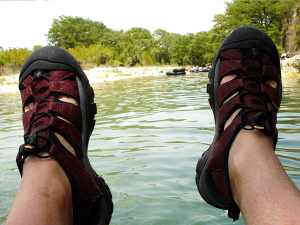 So, what do you need to float the river, anyhow? Like many, i was totally unprepared my first go-round and I quickly realized that I was missing some stuff. When planning a river float trip, there are 15 essential items you will need to float the river and they are:
So, what do you need to float the river, anyhow? Like many, i was totally unprepared my first go-round and I quickly realized that I was missing some stuff. When planning a river float trip, there are 15 essential items you will need to float the river and they are:
- Swimwear
- Sturdy water-worthy shoes
- Head cover (hat)
- Chamois camping towels
- Sunglasses
- Sunblock and bug repellent
- Map of the area
- Identifications, cash and card
- Ice chest with ice, water and snacks
- Large kitchen containers
- Dry bag
- Pelican case
- Inner tubes
- Bungee cords
- Basic first aid kit
Swimwear
Ever look at those swimming pool rules at your apartment complex and wonder why there is usually a rule that says you can’t wear cut-offs in the pool? Yeah, me neither. I’m here to tell you that you can wear almost anything to float the river. You just have to obey public decency laws.
Keep in mind that the best type of clothing is whatever you feel comfortable being wet in for up to 10 (or more) hours. The most ideal clothing, however, would be loose, light-fitting clothes that dry quickly and also have the ability to shield exposed skin from the sun when needed.
Alternatively, these type of clothes could be worn over whatever you decide to wear in the water. Personally, I like lightweight cargo shorts with plenty of pockets so I can carry things. I wear a long sleeve fishing shirt because it will dry fast and I can roll the sleeves down. My days of sun overexposure have long passed.
Sturdy Water-worthy Shoes (And How They Fit Into The 15 Essential Items You Need To Float The River)
Aside from the most basic form of shelter from the elements (clothing), sturdy water-worthy shoes are a necessity to float the river. That is why they are near the top of the 15 essential items you need to float the river list. I touched on this topic in a previous post, but it really deserves an entire post to itself because it is just that important. I’ll stand firm on this advice though, because I have first-hand experience in the form of scraped-up toe knuckles and broken toenails from wearing open-toed sandals to the river. Tevas to be exact. And yes, they were all the rage back in the 90’s.
WEAR SHOES ON THE RIVER. It doesn’t matter if your feet are like that barefoot survival guy’s from Arizona – kicking a river rock will send your little piggies to market faster than you can say “spiral cut honey glazed ham”!
Head Cover (hat)
Often overlooked is a good, wide-brimmed hat. The human head is like a radiator that can lose or gain heat for our bodies very easily, it’s also where we keep our brains, so it makes sense to protect it with at least some kind of basic cover. If I have sunscreen for my face, I like to wear a Buff because they are versatile and help keep the head cool by design. I’ll either wear one of those or a trusty fishing hat, but without all the lures. TIP: take your head wrap or hat off and dip in the cool water to ease a headache or just to cool off. Remember to protect the head.
Chamois or Microfiber Camping Towels
Camping towels revolutionized backpacking and camping. These wonderful items seriously cut down on the space and weight that a traditional bath or beach towel takes up. The next best part about them is, you can wring them out and viola, you’ve got a dry towel again. Throw a couple of these in your dry bag for the end of your float to start getting dry. Even in the summer time, the hill country nights can get cool after the sun goes down behind the hills.
Sunglasses With Retainer (neck strap)
Aside from blocking the sun, sunglasses can also be a very basic form of eye protection. IMPORTANT: glasses displaying Z87 on the lenses are actual “safety glasses”. I’m talking about keeping water, sunlight and fingers from going into your eye, not a projectile. TIP: Polarized sunglasses made for fishing or boating cut the glare on the river, well worth a little extra money in my book. Just be sure to grab some kind of headband, retainer or neck strap to put on them to keep from losing them in the water. Or, make sure you get ones that float.
Sunblock & Bug Repellent
I used to hate sunblock because I wasn’t sure whether to put that on before or after my bug spray. Luckily, Bullfrog had a great idea and made a combo sun-blocking bug repellent. Bullfrog is known for having a high level of water resistance, so it stays on longer. But, as with all sunblock, don’t forget to reapply. On a serious note folks, skin cancer is nothing to laugh about, protect your skin from the sun.
A Map Of The Area (And How It Fits Into The 15 Essential Items You Need To Float The River)
Knowing where you are and where you need to go are key. If you find that you do not have cell service, or if you don’t want to take your phone on the river, be sure to map the area you plan to be in ahead of time.
We love maps here at Frio River Camping and will be adding maps of some of the most popular stretches of the river. In the meantime, feel free to zoom in on our map and take screen shots of your area of interest and print them out. Fold those printed maps and store them in your pelican case.
Don’t be caught by surprise when you realize you can’t find your way around because the person in your group designated to know where you are and where you’re going gets turned around. Most places on the river, as beautiful as they are, start to look the same when you get lost in having fun. It’s very easy to miss an exit point on the river. Your personal float plan should have this information and it is usually designated by the outfitter that drops you at your drop-off point. When in doubt, ask about.
Identification, Cash, Card
In Texas, you are not required by law to carry your ID while on the river, but you may find that some establishments require your ID to rent you things. Additionally, if you are a younger adult, you may need to prove your age if you are purchasing or consuming alcohol in public.
Being able to prove who you are can be a good thing in other situations, so it’s really personal preference, but I choose to carry my ID even on the river. Very easy to pop it into the Pelican case along with a couple different ways to pay for things.
Paper or Plastic? How about both? At the very least, I wouldn’t float the river without some cash. You will, after all need some way to pay for that tube you plan to rent if you go that route.
Ice Chest, Ice, Water, Snacks
Choose an ice chest based on the size of your group, or take more than one. Remember that half of the space inside will be occupied by ice. TIP: to cut down on the amount of ice you’ll need AND to make your ice last longer, put at least 5-10 pounds of dry ice in the bottom on the side OPPOSITE of the drain plug, plop your ice on top of that and then place your drinks and snacks on the drain plug side. The dry ice will turn the loose ice into a big ice block and that mix will stay frozen much longer than ice alone.
Now, even though you are bobbing around in millions of gallons of clean looking water, don’t drink the river water without at least boiling it or sucking it up through a Life Straw. Or, you could just pack water in a reusable plastic container with a snug-fitting lid.
The recommended amount of water is about 1 gallon per person per day. Say, WHAT? Yeah, that’s a lot of water that you aren’t currently drinking. Even though plastic bottles are permitted on the river, try to use reusable containers to cut down on the amount of trash you produce. Outfitters can provide you with mesh trash sacks for your cans and plastic, but they’ve been known to bust open spewing trash all over the beautiful river. Also remember, NO GLASS, EVER.
As cool and convenient as it sounds, subsisting like a fasting monk on beer alone is a great way to get completely wasted and miss out on a good time. Take SOMETHING to eat in that ice chest. I like sandwiches without the bread. I just grab meat and cheese, squirt some stone ground mustard on it and go to town. Corn chips hold up better than potato chips on the river. That brings us to the next section of 15 essential items you need to float the river – Dry Storage.
Large Airtight Kitchen Containers
To put it simply, plastic storage bags are not water tight. That is worth repeating… PLASTIC STORAGE BAGS ARE NOT WATER TIGHT. You may have experienced the very common occurrence of a failing ziploc bag.
If you want to use the plastic storage bags, put your food in them and then lock them inside of an airtight tupperare-type container. One with a good rubber gasket will outperform a plastic baggie alone any day of the week. A 4 quart container should be able to hold everything for a few people for the day. It’s best to take two of them. One for your cold stuff like your lunch meat and cheese, and another to go on the very top of everything for your dry stuff like chips.
Alternatively, you can stuff that container in your dry bag. Even though they are mostly water and air tight, condensation will build up from the dry goods if they are too close to the ice. Likewise, putting your chips in with your lunch meat will make soggy chips. Eew.
Dry Bag (to keep your dry items dry)
A dry bag is a thick rubber bag with a redundant folding closure mechanism. It is almost impossible for anything to get wet inside of one. You will want one large enough to keep your non-edible things in. Your chips will get crushed to pieces in a dry bag, because the dry bag can be strapped onto the side of your ice chest. Bingo, now you have dry storage. For ultra protection of any electronics you want to take with you that are not waterproof, read on to number 12 on the list of 15 essential items you need to float the river.
Pelican Case (for small items)
For the ultimate in waterproofing, do yourself a HUGE favor and get a pelican case. They are nearly indestructible (within reason) and they really are waterproof. If you are OCD and need to be extra sure your phone doesn’t drown, put that pelican case inside of your dry bag.
TIP: Do NOT put your dry bag or pelican case in the ice chest. The ice will create condensation on the INSIDE of the waterproof container that may damage your electronics. I had to learn this the hard way and I lost a water resistant Rhino 110 to condensation created in a pelican case that I put in my ice chest. So sad.
Inner Tubes
This comes down to personal preference, but I like to have my own gear to float the river. I like custom-made stuff so I bought two large truck tire inner tubes and tied pieces of HDPE plastic onto them to make rock guards for the rear end. TIP: whether you rent, buy or build your tube, make sure it has a bottom. The Frio, especially because of it’s low nature, will run your bottom over the roughest of rocks. It doesn’t feel good at all.
The inner tube for my ice chest, like any other water vessel, was christened as “The Supply Ship”. I chose a 60 quart marine ice chest and it fit great in my tube. It was actually shaped more like an oval and I cut my HDPE to match. Even though the ice chest fit snuggly into the tube, I still went a step further and attached the chest to the tube with bungee straps. The straps give me extra attachment points to hook the dry bag onto with a couple of carabiners.
Don’t forget to bring an inflation device with the proper attachments to leave in camp. Make sure your air attachments work with your setup before you reach your destination. I suggest an electric pump. Manual pumps will wear you out quick. Number 14 of our 15 essential items you need to float the river goes really well with inner tubes.
Bungee Cords & Carabiners
If you can comfortably strap it to your spare tube, why not bring it along? Low profile folding camp chairs are great to have if you want to stop somewhere along the river and lounge about. The best way to carry items like this is to strap them to your spare tube on either side of your ice chest.
Maybe you’re into fishing? There are many hours to spend on the river, why not spend a couple catching some fish from the banks? Fishing rods are easily strapped to the tube as well. Just be sure to remove the hooks when doing so as they can puncture tubes as well as skin.
TIP: If your ice chest is strapped to it’s own tube really well, two people should be able to carry the entire setup by the ice chest handles with everything attached. Make sure the handles stay accessible.
Basic First Aid Kit PLUS The Following:
- Hemostatic Gauze (heavy bleeding is hard to stop with a band aid)
- Wet Ones
- Toilet Paper
- Hand Sanitizer
- Nail Clippers
- A Multi-tool (think… removing a fish hook)
Final Thoughts For Our List Of 15 Essential Items You Will Need To Float The River:
Obviously, some items on this list may not be ideal for every individual to pack for the river, but give them all some serious thought, especially the items that could contribute to your safety and well-being. Some people like to travel light, and that’s fine, but don’t skimp on the necessities in order to do so. Remember the saying: It’s always better to have it and not need it than to need it and not have it.
After reading this article, make a list of items that are most important you. Put your kit together BEFORE your river trip. Carry it around, consolidate things, move some things around and see what works. You’ll be glad you did.

